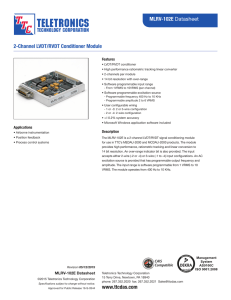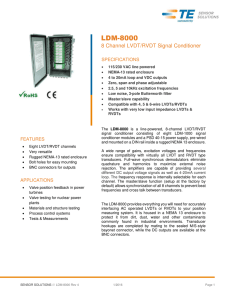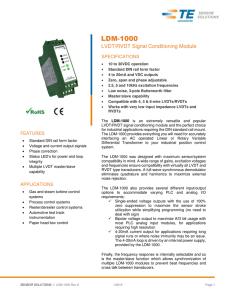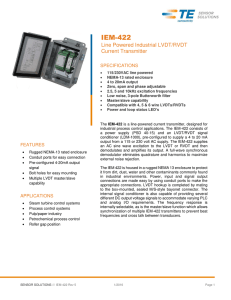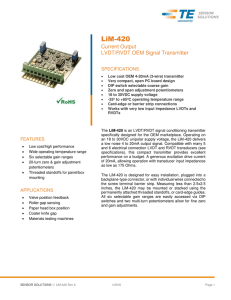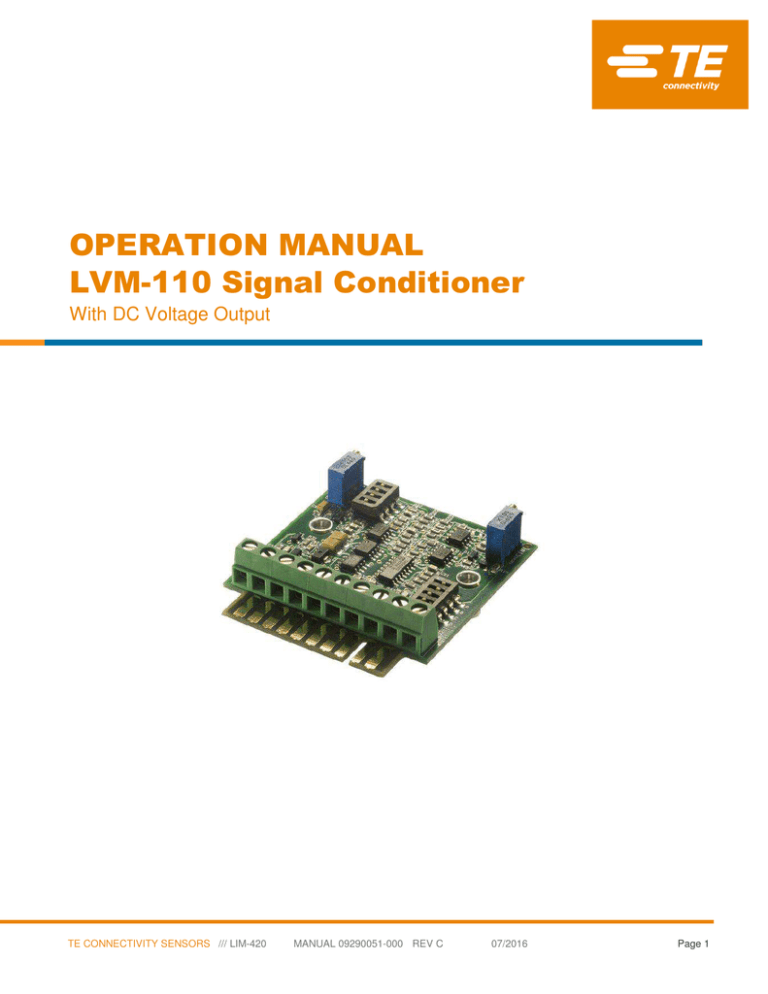
OPERATION MANUAL
LVM-110 Signal Conditioner
With DC Voltage Output
TE CONNECTIVITY SENSORS /// LIM-420
MANUAL 09290051-000 REV C
07/2016
Page 1
LVM-110 SIGNAL CONDITIONER
With DC Voltage Output
Contents
1.
Introduction
3
2.
Product Specifications
3
3.
Product Description
4
4.
Circuit Top View
4
5.
Connection Diagram
4
6.
6.1.
6.2.
6.3.
Initial Setup Procedure
Oscillator Frequency
Oscillator Mode
Oscillator Drive Capability
5
5
5
5
7.
Setting the Amplifier Gain
6
8.
Calibration Procedure (for +/-10 and +/-5VDC Output)
6
9.
Zero Suppression Calibration (for 0 to 10 VDC Output)
7
TE CONNECTIVITY SENSORS /// LIM-420
MANUAL 09290051-000 REV C
07/2016
Page 2
LVM-110 SIGNAL CONDITIONER
With DC Voltage Output
Introduction
The LVM-110 is an LVDT/RVDT (Linear or Rotary Variable Differential Transformer) signal conditioning board with DC voltage
output, primarily designed for OEM process automation applications. The design has been optimized to provide maximum
versatility while offering good performance at a moderate cost.
Product Specifications
For complete specifications and ordering information, please refer to the datasheet at:
http://www.te.com/usa-en/product-CAT-PSI0006.html
ELECTRICAL SPECIFICATIONS
Supply voltage
Supply current
Output voltage ranges
Temperature coefficient of output
Output current
Output noise and ripple
Output impedance
Frequency response
Non-linearity
Stability
Zero suppression
±12VDC or ±15VDC, ±10% (Note; ±15VDC required for ±10VDC output)
±50mA maximum
±5VDC, ±10VDC, 0 to +5VDC, 0 to +10VDC (DIP switch selectable)
±0.02% of FSO per ºF [±0.036% of FSO per ºC] over operating temperature range
5mA maximum
15mV RMS maximum
1Ω maximum
250Hz @ -3 dB, 3-pole Butterworth filter
±0.05% of FSO maximum
±0.05% of FSO maximum (after 15 minute warm-up)
±6VDC total
Transducer excitation
Voltage
Current
Frequency
3VRMS ±10%, sine wave
20mA RMS maximum
2.5, 5, 8 or 10KHz (DIP switch selectable)
Transducer requirements
Transducer type
LVDT/RVDT input impedance
LVDT/RVDT output range
LVDT or RVDT with 5 or 6 electrical connections
150Ω minimum
0.1 to 5.6 VRMS for ±10VDC signal conditioner output
ENVIRONMENTAL AND MECHANICAL SPECIFICATIONS
Operating temperature range
Storage temperature range
Zero and gain adjustments
Electrical connections
Mounting
30°F to +130°F [-1°C to 55°C]
-40°F to +257°F [-40°C to 125°C]
20-turn potentiometers
PC board edge (to backplane-type connector)
or barrier terminal strip; accepts AWG 14 to 30 wire sizes
Use the attached threaded standoffs or card-edge guides
Notes:
All values are nominal unless otherwise noted
FSO (Full Scale Output) is the largest absolute value of the outputs measured at the range ends
TE CONNECTIVITY SENSORS /// LIM-420
MANUAL 09290051-000 REV C
07/2016
Page 3
LVM-110 SIGNAL CONDITIONER
With DC Voltage Output
Product Description
This device is compatible with most, but NOT all, 5 and 6 wire LVDT and RVDT type transducers. Please consult the product
specification to ensure compatibility with your particular sensor.
DIP switches are provided to allow selection of four transducer excitation frequencies, from 2.5 to 10 kHz. Switches are also
provided to select six coarse gain ranges, two zero offsets, and master/slave or standalone operation.
Installation may be accomplished by use of the card-edge connector or threaded stand-offs and screw-lock barrier strip
connections.
The next few pages will take you, step by step, through the simple set-up and calibration process. This device may be set-up for
several different full scale analog outputs; some of the potential configurations are listed below:
±10 VDC output
±5 VDC output
0 to 10 VDC output
Standalone operation
Master/slave operation
Circuit Top View
Connection Diagram
TE CONNECTIVITY SENSORS /// LIM-420
MANUAL 09290051-000 REV C
07/2016
Page 4
LVM-110 SIGNAL CONDITIONER
With DC Voltage Output
Initial Setup
In order to begin this process, you must first know a few basic characteristics about the LVDT or RVDT you intend to use with
the LVM-110 conditioning board. The information may be obtained from the sensor calibration sheet, catalog literature, or
datasheet. The list below is the minimum information required to perform a successful calibration:
Recommended operating frequency
Sensitivity at that frequency
Primary (input) impedance at that frequency
The ± full scale (inch or degree) you intend to calibrate over
Analog output signal required by your application
6.1. Oscillator Frequency
Once you have established the proper excitation frequency for your transducer, refer to the table below and the DIP switch
locations on the Circuit Top View (in this manual) to set the LVM-110 oscillator frequency:
Oscillator
Frequency
S1-C
S1-D
2.5 KHZ
OFF
OFF
5 KHZ
ON
OFF
8 KHZ
OFF
ON
10 KHZ
ON
ON
(Refer to Circuit Top View in this manual for ON/OFF positions)
6.2. Oscillator Mode
The Oscillator mode setting depends on the number of LVM-110’s and LVDT/RVDTs in your system. For a single LVDT or RVDT
system, run the LVM-110 in the stand alone (master) mode. For multi sensor systems, it is best to master and slave the LVM110 oscillators to prevent beat frequencies and crosstalk between amplifiers and LVDTs. Select one LVM-110 to serve as the
master oscillator, and setup the balance in the slave mode.
CAUTION
Attempting to synchronize two LVM-110 set as masters may damage one or both units.
Connecting Pin-1 (Sync) of the barrier strip, from unit to unit, will complete the sync bus circuit. The power common serves as
the return line. Use the table below to configure your oscillator mode:
S1-B
Mode
OFF
ON
SLAVE
MASTER
6.3. Oscillator Drive Capability
To ensure LVDT/RVDT compatibility with the LVM-110 you must know the transducer current draw. The LVM-110 is designed
with a robust sine wave oscillator; it is rated for a maximum drive current of 20mA RMS with a fixed amplitude of 3 VRMS. To
ensure compatibility, you will need to know the LVDT/RVDT input impedance for the frequency at which you intend to operate
it. The transducer input impedance must be equal to or greater than 150 Ohms, which will result in current draw of 20mA
or less. The input impedance information is available on the datasheets for all our LVDTs and RVDTs.
TE CONNECTIVITY SENSORS /// LIM-420
MANUAL 09290051-000 REV C
07/2016
Page 5
LVM-110 SIGNAL CONDITIONER
With DC Voltage Output
Setting the Amplifier Gain
Calculate the LVDT or RVDT full scale output, using the simple formula below:
LVDT/RVDT sensitivity (in V/V/inch or V/V/degree), at the selected frequency
multiplied with
The excitation voltage, (3 VRMS for the LVM-110)
multiplied with
The full scale of the LVDT in inches (or RVDT in degrees)
As an example, the calculation for an HR1000 LVDT (±1 inch range; 1 inch full scale), with a sensitivity of 0.39V/V/inch at
2.5KHZ, would be done as follows:
0.39 x 3 x 1 = 1.17 VRMS full scale output or 1.17 VRMS at ± 1 inch
Using the Gain Selection Table below, select the coarse gain settings (S1 and S2 DIP switches for the two amplification stages)
for the range the full scale output falls into. In our example, you would use the x0.2 HIGH, or the x0.5 LOW settings; either will
work, due to range overlap. The gain selections are for a ±10 VDC LVM-110 full scale output.
To calibrate the LVM-110 with your LVDT or RVDT for a ±5 VDC output, double the result of your full scale output calculation,
prior to consulting the gain table. This will result in you selecting half the normal gain, therefore half the normal DC output.
Gain Selection Table:
First Stage
Second Stage
LVDT Full Scale Output
Gain
S2-A
S2-B
Gain Lo/Hi
S1-A
for ±10VDC output
x0.2
x0.2
x0.5
x0.5
x2
OFF
OFF
ON
ON
OFF
OFF
OFF
OFF
OFF
ON
LOW
HIGH
LOW
HIGH
LOW
ON
OFF
ON
OFF
ON
2.10 to 5.55 VRMS
1.00 to 2.64 VRMS
0.84 to 2.22 VRMS
0.40 to 1.00 VRMS
0.21 to 0.55 VRMS
x2
OFF
ON
HIGH
OFF
0.10 to 0.26 VRMS
Calibration Procedure (for +/-10 and +/-5VDC Output)
Using the Connection Diagram in this manual, connect the LVDT or the RVDT, a DC voltmeter, and a bipolar power supply to
the LVM-110. Turn power on and allow 15 minute warm-up.
Note: Changing coarse gain settings (DIP switches) after Step 6 below may result in a zero shift. Should you find it necessary
to change the gain, you should repeat steps 1 through 6.
Step 1: Disconnect the LVDT/RVDT secondary lead-wire (black) from terminal 8
Step 2: Place a temporary shorting jumper across terminals 6 and 8 (to short the LVM-110 input)
Step 3: Adjust the ZERO potentiometer for zero volt DC output, between terminals 9 (GND) and 10 (OUT)
Step 4: Remove shorting jumper and reconnect the black wire to terminal 8
Step 5: Move the LVDT core or rotate the RVDT shaft to the approximate center of the mechanical range, then to the
transducer null (as close as possible to zero VDC output between pins 9 and 10)
Step 6: Using the ZERO potentiometer, adjust out any remaining output signal, due to positioning difficulty
Step 7: Using a gage block micrometer or other precision positioning device, displace the LVDT core or rotate the RVDT
shaft in a positive direction (positive DC voltage between pins 9 and 10) to the full scale position used in your
calculation (see “Setting the amplifier Gain”; +1 inch in our HR1000 LVDT example)
Step 8: Adjust the GAIN potentiometer for the required positive full scale DC output (5 or 10VDC) between pins 9 and 10
Step 9: Return to the original zero position to re-check your null DC voltage between pins 9 and 10
Step 10: Displace the LVDT core or rotate the RVDT shaft to the negative full scale position (negative DC voltage between
pins 9 and 10). You should measure approximately the same DC voltage (except negative) at this location as at
the positive full scale position.
TE CONNECTIVITY SENSORS /// LIM-420
MANUAL 09290051-000 REV C
07/2016
Page 6
LVM-110 SIGNAL CONDITIONER
With DC Voltage Output
Zero Suppression Calibration (for 0 to 10 VDC Output)
To perform a 0 to 10 VDC calibration, follow the instructions for the ±5 VDC calibration, then displace the LVDT core or the
RVDT shaft to the minus full scale position (-5VDC output between pins 9 and 10). Using the table below, select a +4 Volt offset:
S2-C
S2-D
Offset
OFF
OFF
None
ON
OFF
-4VDC
OFF
ON
+4VDC
After zero switches are set, the output at the minus full scale position should have changed to –1VDC approximately.
Using the ZERO potentiometer, adjust the DC output until it changes to zero VDC, from the original -1VDC. Return to the original
zero (mid) position; you should now read +5 Volts DC instead of zero. Continue in the same direction up to the original positive
full scale position; the reading should be +10 VDC. The output was shifted by +5VDC; your calibration is now complete for a 0
to 10VDC output range.
Other custom DC output ranges can be achieved by using different ZERO potentiometer adjustments and/or offset switch
settings.
NORTH AMERICA
EUROPE
ASIA
Measurement Specialties, Inc.,
a TE Connectivity Company
1000 Lucas Way
Hampton, VA 23666
United States
Phone: +1-800-745-8008
Fax: +1-757-766-4297
Email: customercare.hmpt@te.com
MEAS Deutschland GmbH
a TE Connectivity Company
Hauert 13
D-44227 Dortmund
Germany
Phone: +49-(0)231-9740-0
Fax: +49-(0)231-9740-20
Email: customercare.dtmd@te.com
Measurement Specialties China Ltd.,
a TE Connectivity Company
No. 26, Langshan Road
High-tech Park (North)
Nanshan District, Shenzhen 518057
China
Phone: +86-755-33305088
Fax: +86-755-33305099
Email: customercare.shzn@te.com
te.com/sensorsolutions
Measurement Specialties, Inc., a TE Connectivity company.
Measurement Specialties (MEAS), American Sensor Technologies (AST), TE Connectivity, TE Connectivity (logo) and EVERY CONNECTION COUNTS are trademarks. All other logos,
products and/or company names referred to herein might be trademarks of their respective owners.
The information given herein, including drawings, illustrations and schematics which are intended for illustration purposes only, is believed to be reliable. However, TE Connectivity makes
no warranties as to its accuracy or completeness and disclaims any liability in connection with its use. TE Connectivity‘s obligations shall only be as set forth in TE Connectivity‘s Standard
Terms and Conditions of Sale for this product and in no case will TE Connectivity be liable for any incidental, indirect or consequential damages arising out of the sale, resale, use or misuse
of the product. Users of TE Connectivity products should make their own evaluation to determine the suitability of each such product for the specific application.
© 2016
TE Connectivity Ltd. family of companies
All Rights Reserved.
TE CONNECTIVITY SENSORS /// LIM-420
MANUAL 09290051-000 REV C
07/2016
Page 7

